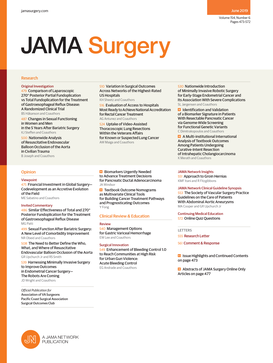2002-2022年丹麦重大急诊腹部手术后临床结果趋势
IF 15.7
1区 医学
Q1 SURGERY
引用次数: 0
摘要
重要意义重大急诊腹部手术与高发病率和死亡率相关。了解结果随时间变化的趋势可以揭示关键的实践改进,确定术后护理的差距,并为未来的研究建立大规模的基准。目的探讨丹麦重大急诊腹部手术后的发病率和死亡率变化趋势。设计、环境和参与者这是一项全国性的、基于人群的队列研究。根据丹麦全国行政登记处的数据进行分析。在丹麦的公共卫生保健系统中,所有从2002年到2022年接受重大紧急腹部手术的成年患者都被纳入其中。主要的紧急腹部手术包括由于腹部内病变,包括肠穿孔、缺血、肠梗阻、脓肿或出血而进行剖腹或腹腔镜手术。主要的紧急腹部手术。主要结局和测量主要结局是急诊腹部大手术后30天和90天死亡率随时间的变化趋势。结果共61476例患者(平均[SD]年龄66.2[16.3]岁;其中女性34827例(56.7%)。每年手术数量保持不变,平均(SD)为3044(165)例/年。30天和90天的死亡率分别从25%和33%降至13%和18% (P <;措施)。中位(IQR)住院时间从10(5-17)天减少到6(4-13)天(P <;措施)。术后30天并发症发生率(分类Clavien-Dindo≥3a)从49%降至44% (P < 0.001), 90天并发症发生率从53%降至48% (P < 0.001),但有更多患者接受早期干预的趋势。30天和90天的再入院率分别从9%和13%急剧上升到25%和33% (P <;措施)。结论和相关性本队列研究的结果表明,重大急诊腹部手术后死亡率和住院时间显著降低。再入院率明显增加,术后并发症持续高发。这些转变强调了加强术后监测和出院后随访的必要性。本文章由计算机程序翻译,如有差异,请以英文原文为准。
Trends in Clinical Outcomes After Major Emergency Abdominal Surgery in Denmark, Data From 2002-2022
ImportanceMajor emergency abdominal surgery is associated with high morbidity and mortality. Understanding trends in outcomes over time can reveal critical practice-changing improvements, identify gaps in postoperative care, and establish a large-scale benchmark for future research.ObjectiveTo investigate trends in morbidity and mortality after major emergency abdominal surgery in Denmark.Design, Setting, and ParticipantsThis was a nationwide, population-based cohort study. Analyses were performed based on data from Danish nationwide administrative registries. Within the public health care system in Denmark, all adult patients undergoing major emergency abdominal surgery from 2002 to 2022 were included. Major emergency abdominal surgeries included laparotomy or laparoscopy due to intra-abdominal pathologies, including intestinal perforation, ischemia, bowel obstruction, abscess, or bleeding.ExposureMajor emergency abdominal surgery.Main Outcomes and MeasuresThe primary outcome was the trend in 30- and 90-day mortality after major emergency abdominal surgery over time.ResultsA total of 61 476 patients (mean [SD] age, 66.2 [16.3] years; 34 827 female [56.7%]) were included. The annual number of surgeries remained constant, with a mean (SD) of 3044 (165) surgeries per year. The 30- and 90-day mortality was reduced from 25% and 33%, respectively, to 13% and 18%, respectively (P &lt; .001). Median (IQR) hospital length of stay was decreased from 10 (5-17) days to 6 (4-13) days (P &lt; .001). The rate of 30-day postoperative complications (classified Clavien-Dindo ≥3a) was reduced from 49% to 44% (P &lt;.001) and the 90-day rate was reduced from 53% to 48% (P &lt;.001), however, with a tendency toward more patients undergoing earlier intervention. The 30- and 90-day readmission rate increased drastically from 9% and 13%, respectively, to 25% and 33%, respectively (P &lt; .001).Conclusions and RelevanceResults of this cohort study suggest notable reductions in mortality and hospital length of stay after major emergency abdominal surgery. A marked increased readmission rate and a persistently high rate of postoperative complications were found. These shifts underscore the need for enhanced postoperative monitoring and postdischarge follow-up.
求助全文
通过发布文献求助,成功后即可免费获取论文全文。
去求助
来源期刊

JAMA surgery
SURGERY-
CiteScore
20.80
自引率
3.60%
发文量
400
期刊介绍:
JAMA Surgery, an international peer-reviewed journal established in 1920, is the official publication of the Association of VA Surgeons, the Pacific Coast Surgical Association, and the Surgical Outcomes Club.It is a proud member of the JAMA Network, a consortium of peer-reviewed general medical and specialty publications.
 求助内容:
求助内容: 应助结果提醒方式:
应助结果提醒方式:


